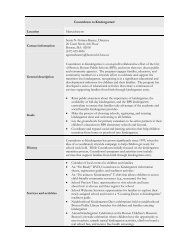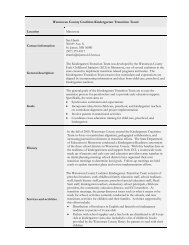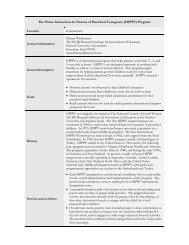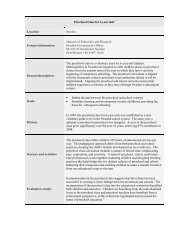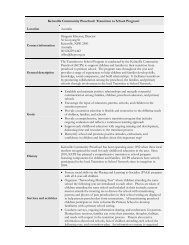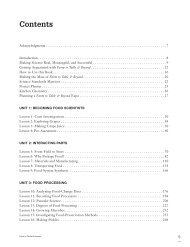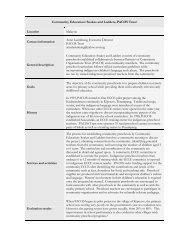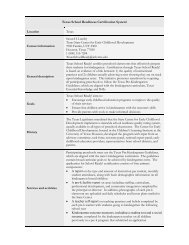Proceedings of the Fourth Annual Teachers College Educational ...
Proceedings of the Fourth Annual Teachers College Educational ...
Proceedings of the Fourth Annual Teachers College Educational ...
Create successful ePaper yourself
Turn your PDF publications into a flip-book with our unique Google optimized e-Paper software.
“Media Literacy in Action: Using Teaching for Understanding and<br />
Universal Design for Learning to Develop a Media Literacy Lesson<br />
Series”<br />
Jennifer Lavalle,<br />
Harvard Graduate School <strong>of</strong> Education, 1 Appian Way, Cambridge, MA 02138,<br />
Email: JLL610@mail.harvard.edu<br />
Abstract: This project integrates a blended learning environment into a media literacy<br />
lesson series designed for a sixth grade health classroom. Using Teaching for<br />
Understanding and Universal Design for Learning as guiding models, this project<br />
emphasizes <strong>the</strong> need for media literacy in school curricula and uses <strong>the</strong>se learning<br />
frameworks to structure <strong>the</strong> implementation <strong>of</strong> such activities. This presentation will<br />
comment on <strong>the</strong> <strong>the</strong>oretical foundations <strong>of</strong> this project and will explain <strong>the</strong> activities <strong>of</strong> <strong>the</strong><br />
lesson series. Though this project is designed specifically for a middle school audience,<br />
<strong>the</strong> process <strong>of</strong> integrating 21 st century learning skills into a traditional classroom using<br />
frameworks for educational design is applicable for all ages and grade levels.<br />
Introduction<br />
Today’s children are growing up in increasingly interconnected and ubiquitous media environments.<br />
These children engage with media technologies in unforeseen ways and with unprecedented frequency.<br />
According to authors Douglas Thomas and John Seely Brown (2011), we are experiencing a dramatic<br />
shift to a new culture <strong>of</strong> learning based on three principles: “(1) The old ways <strong>of</strong> learning are unable to<br />
keep up with our rapidly changing world. (2) New media forms are making peer-to-peer learning easier<br />
and more natural. (3) Peer-to-peer learning is amplified by emerging technologies that shape <strong>the</strong><br />
collective nature <strong>of</strong> participation with those new media” (p. 50).<br />
In this new culture <strong>of</strong> learning, behaviors and practices are evolving. As such, educators must rethink<br />
teaching methodology with a keen focus on <strong>the</strong>se new learners. If <strong>the</strong> majority <strong>of</strong> child’s time is spent in<br />
an out <strong>of</strong> school environment, what are children learning in this Out-<strong>of</strong>-School-Time (OST)? In fact,<br />
approximately 85% <strong>of</strong> a child’s day is spent in OST (Bransford et al, 1999, p.148). Since we know that<br />
children are engaged in learning activities during this time, <strong>the</strong> question for educators thus becomes: what<br />
are <strong>the</strong>y learning and how can we harness <strong>the</strong> power <strong>of</strong> this learning to fur<strong>the</strong>r academic knowledge? In<br />
o<strong>the</strong>r words, how do we scaffold a student’s navigation through new digital playgrounds?<br />
This question is at <strong>the</strong> forefront <strong>of</strong> many minds and several initiatives have been developed around <strong>the</strong><br />
idea what it means to be a 21 st century learner. With national initiatives like <strong>the</strong> Common Core State<br />
Standards providing <strong>the</strong> overarching goals for educators, it is necessary for researchers and curriculum<br />
designers to provide <strong>the</strong> means for such instruction. This project syn<strong>the</strong>sizes and applies modern<br />
learning <strong>the</strong>ories in order to produce a lesson series fit for classroom implementation. Teaching for<br />
Understanding and Universal Design for Learning are <strong>the</strong> principal frameworks that underlie and support<br />
this learning series.<br />
Curriculum Frameworks<br />
Teach for Understanding (Wiske, 1997) is a curriculum framework that proposes four principle areas for<br />
lesson design: generative topics, understanding goals, performances <strong>of</strong> understanding, and ongoing<br />
assessments. This framework is <strong>the</strong> guiding model for this lesson series, making it accessible and<br />
comprehensive for all teachers. Secondly, Universal Design for Learning (Meyer & Rose, 2005) is used<br />
as an overarching <strong>the</strong>me in this lesson series to ensure multiple points <strong>of</strong> entry for all students with a<br />
variety <strong>of</strong> needs, preferences, and abilities.<br />
Media Literacy Education<br />
Though <strong>the</strong>se learning frameworks may be familiar to many educators, <strong>the</strong> topic <strong>of</strong> media literacy is <strong>of</strong>ten<br />
new. In many classrooms across <strong>the</strong> United States, media literacy is treated as an afterthought to <strong>the</strong><br />
38



